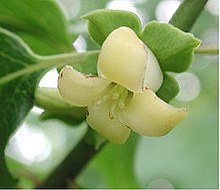Persimmons
| Persimmon | |
|---|---|
 |
|
| Persimmon flower | |
| Scientific classification | |
| Kingdom: | Plantae |
| (unranked): | Angiosperms |
| (unranked): | Eudicots |
| (unranked): | Asterids |
| Order: | Ericales |
| Family: | Ebenaceae |
| Genus: | Diospyros |
| Species | |
|
See text |
|
| Nutritional value per 100 g (3.5 oz) | |
|---|---|
| Energy | 293 kJ (70 kcal) |
|
18.59 g
|
|
| Sugars | 12.53 g |
| Dietary fiber | 3.6 g |
|
0.19 g
|
|
|
0.58 g
|
|
| Vitamins | |
| Vitamin A equiv. |
(10%)
81 μg
(2%)
253 μg834 μg
|
| Thiamine (B1) |
(3%)
0.03 mg |
| Riboflavin (B2) |
(2%)
0.02 mg |
| Niacin (B3) |
(1%)
0.1 mg |
| Vitamin B6 |
(8%)
0.1 mg |
| Folate (B9) |
(2%)
8 μg |
| Choline |
(2%)
7.6 mg |
| Vitamin C |
(9%)
7.5 mg |
| Vitamin E |
(5%)
0.73 mg |
| Vitamin K |
(2%)
2.6 μg |
| Minerals | |
| Calcium |
(1%)
8 mg |
| Iron |
(1%)
0.15 mg |
| Magnesium |
(3%)
9 mg |
| Manganese |
(17%)
0.355 mg |
| Phosphorus |
(2%)
17 mg |
| Potassium |
(3%)
161 mg |
| Sodium |
(0%)
1 mg |
| Zinc |
(1%)
0.11 mg |
|
|
|
|
|
| Percentages are roughly approximated using US recommendations for adults. Source: USDA Nutrient Database |
|
| Nutritional value per 100 g (3.5 oz) | |
|---|---|
| Energy | 531 kJ (127 kcal) |
|
33.5 g
|
|
| Sugars | n/a |
| Dietary fiber | n/a |
|
0.4 g
|
|
|
0.8 g
|
|
| Vitamins | |
| Vitamin C |
(80%)
66 mg |
| Minerals | |
| Calcium |
(3%)
27 mg |
| Iron |
(19%)
2.5 mg |
| Phosphorus |
(4%)
26 mg |
| Potassium |
(7%)
310 mg |
| Sodium |
(0%)
1 mg |
|
|
|
|
|
| Percentages are roughly approximated using US recommendations for adults. Source: USDA Nutrient Database |
|
See text
The persimmon /pərˈsɪmən/ (sometimes spelled persimon) is the edible fruit of a number of species of trees in the genus Diospyros. The most widely cultivated of these is the Oriental or Japanese persimmon, Diospyros kaki.Diospyros is in the family Ebenaceae, and a number of non-persimmon species of the genus are grown for ebony timber.
The word Diospyros comes from the ancient Greek words "dios" (δῐος) and "pyron" (πῡρον). A popular etymology construed this as "divine fruit", or as meaning "wheat of Zeus" or "God's pear" and "Jove's fire". The dio-, as shown by the short vowel 'i' has nothing to do with 'divine' (δῑoς ), dio- being an affix attached to plant names, and in classical Greek the compound referred to 'the fruit of the nettle tree'. The Modern Greek name for the fruit is λωτός (lotos), which leads modern Greeks to the assumption that this is the lotus referred to in Homer's Odyssey.
The word persimmon itself is derived from putchamin, pasiminan, or pessamin, from Powhatan, an Algonquian language of the eastern United States, meaning "a dry fruit".
The tree Diospyros kaki is the most widely cultivated species of persimmon. Typically the tree reaches 4.5 to 18 metres (15 to 59 ft) in height and is round-topped. It stands erect, but sometimes can be crooked or have a willowy appearance.
...
Wikipedia
